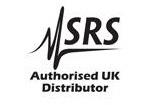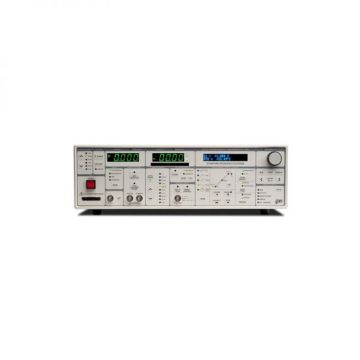SRS QCM200 Quartz Crystal Microbalance
The QCM200 Quartz Crystal Microbalance from Stanford Research Systems measures mass and viscosity in processes occurring at or near surfaces, or within thin films. This system includes a controller, crystal oscillator electronics, crystal holder, three quartz crystals, and Windows software.
Lambda Exclusive Promotion:
Additional 12 months warranty for free (2 years total) via our UK Service Centre.
The SRS QCM200 Quartz Crystal Microbalance reads the resonant frequency and resistance of a 5 MHz, AT-cut quartz crystal. The resonant frequency changes as a linear function of the mass of material deposited on the crystal surface. The resistance at resonance changes with the viscosity/elasticity of the material (film or liquid) in contact with the crystal surface.
As a gravimetric instrument, the SRS QCM200 can measure mass ranging from micrograms to fractions of a nanogram. Detection limits correspond to submonolayers of atoms. Observations of conformational changes, such as phase transitions, swelling, and cross-linking, can easily be made.
Specifically designed to handle heavy loads (up to 5 kΩ), the instruments will maintain oscillation in aqueous solutions containing over 88 % glycerol (w/w %). It is ideal for studies involving lossy films and highly viscous liquids.
The SRS QCM200 is a stand-alone instrument with a built-in frequency counter and resistance meter. Series resonance frequency and resistance are measured and displayed, and there is an analog output proportional to frequency which can be used to interface with a potentiostat. The QCM200 can be operated from the front panel or a PC using the RS-232 interface. Windows software is provided for real-time data acquisition, display, analysis and storage. Both frequency and resistance trends can be viewed. User-tags are provided to time-stamp important events.
The stability and accuracy of the QCM200 are ideal for most experiments. For special applications requiring optimum long-term frequency stability, a precision timebase, such as the SRS FS725 Rubidium Frequency Standard, can be connected to the external 10 MHz input.
QCM Electronics
A unique automatic gain control circuit provides the quartz crystal with the required signal amplitude to overcome viscoelastic losses and achieve series resonance. It also monitors the energy dissipated by the sensor, which is used to determine the series resistance of the crystal. The controller provides power to the crystal oscillator electronics, and includes a potentiometer for canceling shunt capacitance. Proper capacitance cancellation is required to assure true series resonance operation of the crystal oscillator, and to eliminate frequency and resistance errors.
In the QCM200, the digital controller also contains a frequency counter with 0.01 Hz resolution for accurate frequency measurements, and a resistance meter with 5 digits of resolution covering a range of 0 to 5000 Ω.
Crystals, Holder and Flow Cell
The QCM200 uses a 5 MHz, 1" diameter, AT-cut quartz crystal wafer with circular electrodes on both sides. Crystals are available in a variety of materials. The crystal holder is a rugged, compact, easy to use fixture. The holder and all crystals may be used in liquid or gas environments.
An optional axial flow cell adapter attaches to the standard crystal holder. This provides an easy way of interfacing the QCM to a flow injection analysis system.
EQCM
The figure below illustrates a typical EQCM experiment. The frequency analog output of the QCM controller is connected to the potentiostat A/D input. The potentiostat digitizes the voltage, and it's software displays relative frequency changes synchronous with the electrochemical data. The versatile QCM200 can be easily integrated into any custom 5 MHz crystal based EQCM setup.For EQCM applications, an analog output proportional to frequency shift may be directly connected to a potentiostat or galvanostat. Only the front-surface electrode of the crystal is exposed to the solution. This electrode is also transformer isolated, as required for EQCM operation.
In the Lab
The QCM200 is a valuable research tools for applications ranging from pure surface science to biochemistry. Quartz crystals can be pre-coated with any thin film material including organic polymers, hydrogels, composites, ceramics, biomolecules, bacteria and living cells. This provides unlimited potential for the development of novel gas and biological sensors.
The quartz crystal microbalance is an essential addition to any biological laboratory. The data from a QCM perfectly complements that obtained from other techniques, such as surface plasmon resonance (SPR) and atomic force microscopy (AFM), aiding in the analysis of complex biological interactions.
QCM200 Software
A Windows software program is included to facilitate remote operation and simplify data acquisition.
Applications
- Immunosensors
- Sorption sensors
- Moisture analyzers
- Particulate monitors
- Contamination monitors
- Electrovalency measurements
- Hydrogen absorption on metal films
- Bubble formation
- Redox and conductive polymer research
- Double-layer characterization
- Corrosion studies
- Surface oxidation
- DNA and RNA hybridization studies
- Antigen-antibody reactions
- Protein adsorption
- Detection of virus capsids, bacteria, mammalian cells
- Biofouling and antifouling
- Biomembranes and biomaterials
- Protein-protein interactions
- Self-assembled monolayers (SAMs)
- Molecularly imprinted polymers (MIPs)
- Langmuir/Langmuir-Blodgett films
- Laser ablation, desorption and breakdown studies
- MEMS nanomaterials
- Intelligent biomaterials.
|
QCM200 Quartz Crystal Microbalance |
|
|
Frequency Measurement |
|
|
Frequency display |
|
|
Resolution |
0.01 Hz (10 second gate) |
|
Gate time |
0.1 s, 1 s, 10 s, user-selectable |
|
Measurement (using internal timebase) |
|
|
Stability |
<4 × 10-9 Allan Variance (typ.) |
|
Accuracy |
±1.5 ppm |
|
Analog output |
|
|
Δf output |
±10 V full scale (20-bit) |
|
Ranges |
±200 kHz, ±100 kHz, ±50 kHz, |
|
Frequency output |
|
|
Frequency |
5 MHz (nominal) |
|
Level |
TTL (square wave) |
|
Source impedance |
50 Ω |
|
Ext. timebase input |
|
|
Frequency |
10 MHz |
|
Level |
1 Vpp (nominal) |
|
Resistance Measurement |
|
|
Resistance display |
|
|
Range |
0 to 5000 Ω |
|
Resolution |
5 digits: |
|
Conductance output (Vc) |
|
|
Resistance |
R = 10,000 x (10-Vc/5) - 75 Ω |
|
Resistance range |
0 to 5000 Ω |
|
Voltage level |
0 to 10.625 VDC, log scale |
|
Impedance |
1 kΩ |
|
Capacitance Cancellation |
|
|
Range |
10 pF to 40 pF (20 pF nominal) |
|
Limit |
0.01 pF |
|
Physical |
|
|
Analog connectors |
BNC |
|
Interface |
RS-232, 9600 baud |
|
Dimensions |
10.625" × 2" × 7" (WHL) |
|
Crystal holder |
|
|
Material |
Holder: Kynar®, O-ring: Viton® |
|
Cable type, length |
Cat-5, 3 ft. |
|
Dimensions, weight |
10.6" × 2" × 7" (WHL), 2 lbs. |
|
Operating temperature |
0 °C to 40 °C |
|
Power |
15 W, 100/120/220/240 VAC, 50/60 Hz |
|
Quartz Crystals (polished) |
|
|
Frequency |
5 MHz, AT-cut, plano-plano |
|
Diameter |
1 inch |
|
Electrodes |
Cr/Au (Ti/Au, Ti/Pt opt.) |
![]() Stanford Research Systems QCM200 datasheet
Stanford Research Systems QCM200 datasheet
![]() Stanford Research Systems QCM200 operating manual
Stanford Research Systems QCM200 operating manual
![]() Selected Literature Citations of SRS QCM100/200
Selected Literature Citations of SRS QCM100/200
![]() Quartz Crystal Microbalance References
Quartz Crystal Microbalance References
![]() High Temperature Microbalances
High Temperature Microbalances
![]() Quartz Crystal Microbalance Theory
Quartz Crystal Microbalance Theory
![]() Why buying from Lambda makes sense
Why buying from Lambda makes sense
| Photo | Product | SKU |
|---|






